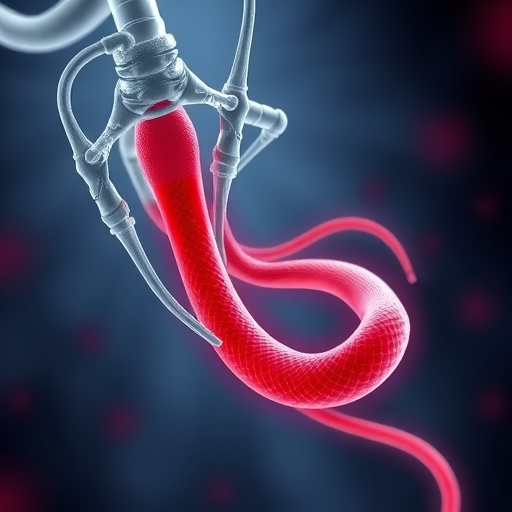
A groundbreaking study from the University of Queensland has cast a new light on the efficacy of antivenoms used to treat bites from the notorious Eastern Brown Snake (Pseudonaja textilis), widely considered one of Australia’s most venomous snakes. This research challenges long-held assumptions about the uniformity of brown snake venom and suggests that current antivenom formulations might not be optimally effective for every case, especially considering geographic variations in venom composition. The study, led by Professor Bryan Fry at UQ’s School of the Environment, unveils striking biochemical differences within the venom of Eastern Brown Snake populations inhabiting northern and southern regions of Australia, with profound implications for clinical treatment.
Through meticulous biochemical analysis using thromboelastography—a sophisticated technique assessing the dynamics of blood clot formation and stability—the research team demonstrated that the venoms from northern and southern Eastern Brown Snake populations act distinctly on the human coagulation system. Venom sourced from southern populations induces the formation of robust, stable blood clots akin to those produced by the highly venomous Coastal Taipan (Oxyuranus scutellatus), whereas venoms from northern snakes and other brown snake species trigger faster but far more fragile clots that are prone to rapid breakdown. This dichotomy in procoagulant activity reveals a complex evolutionary landscape and underscores how a “one-size-fits-all” approach to antivenom production may neglect crucial regional variations.
The clinical repercussions of these findings cannot be overstated. Brown snake envenomation often leads to severe coagulopathy, characterized by systemic consumption of clotting factors, internal hemorrhage, and multi-organ failure. Yet, if the antivenom deployed doesn’t adequately neutralize the specific venom proteins responsible for either stable or fragile clots, patients could face inconsistent outcomes. Currently, brown snake antivenom production pools venoms of unspecified geographic origin to create a generalized immunogen. Professor Fry emphasizes that such indiscriminate pooling may undermine treatment consistency, as it might fail to elicit antibodies crucial for neutralizing the distinct northern or southern venom phenotypes.
.adsslot_biE47OsPw0{width:728px !important;height:90px !important;}
@media(max-width:1199px){ .adsslot_biE47OsPw0{width:468px !important;height:60px !important;}
}
@media(max-width:767px){ .adsslot_biE47OsPw0{width:320px !important;height:50px !important;}
}
ADVERTISEMENT
This revelation also sheds light on an overlooked factor in snakebite medicine—the influence of geographical and genetic divergence on venom composition. The research team’s genetic sequencing efforts pinpoint a genetic bifurcation within Eastern Brown Snake populations that aligns precisely with the segregation in venom effects. Southern populations, which predominantly prey on reptiles, have evolved venom to induce sturdy blood clots, potentially incapacitating cold-blooded prey effectively. In contrast, northern populations consuming mostly mammals produce venoms triggering fleeting clot formation. This evolutionary fine-tuning of venom profiles accentuates the dynamic interplay between diet, ecology, and venom biochemistry.
Professor Fry argues that evolutionary adaptations such as these necessitate a paradigm shift toward “precision toxicology” in managing snakebite envenomation. Instead of relying solely on historically standardized antivenoms, clinicians and researchers could work toward developing region-specific antivenoms or polyvalent formulations tailored to neutralize divergent venom phenotypes. This approach would promise enhanced efficacy, reduce adverse reactions, and ultimately save more lives by aligning treatment protocols with the precise venom chemistry encountered.
The study also advocates for a comprehensive re-examination of clinical records, particularly hospital chart data, to disentangle outcomes associated with northern versus southern Eastern Brown Snake bites. Since the southern strong-clot lineage exists in habitats without other brown snake species, spatial analysis of envenomation cases can yield valuable insights into differences in clinical manifestations and antivenom responses. Such retrospective data mining, combined with ongoing biochemical and genetic investigations, has the potential to revolutionize clinical guidelines and inform public health policies.
Another critical aspect of Professor Fry’s work involves rigorous testing of currently available human and veterinary antivenoms against the distinct venom profiles identified. Preliminary evidence suggests that regional venom differences could influence antivenom binding and neutralization capacity, thereby accounting for documented cases where standard antivenoms exhibit variable efficacy. This highlights an urgent need to reassess and possibly reformulate antivenoms to address intraspecific venom variation and improve therapeutic consistency across Australia’s diverse ecological zones.
The implications of this research extend beyond Australian elapids and touch upon broader questions within toxinology and clinical toxin treatment globally. Venom heterogeneity within species is recognized but often underestimated, and this study provides a compelling case of how ecological pressures shape venom evolution with direct medical consequences. By bridging the evolutionary biology of snake venoms with clinical toxinology, Professor Fry’s team opens avenues for cross-disciplinary collaboration between herpetologists, molecular biologists, clinicians, and pharmacologists.
Moreover, the usage of thromboelastography in this context demonstrates the power of cutting-edge analytical tools to unravel complex venom effects on coagulation pathways. Traditional coagulation assays measure endpoint outcomes like clotting time but fail to capture the mechanical stability and dynamic properties of clots, aspects critical in understanding venom action and appropriate clinical response. This methodological advancement enhances understanding of the specific mechanisms by which different venom toxins modulate the coagulation cascade, providing precise targets for antivenom development.
The study’s context is deeply intertwined with Australia’s public health landscape, given the Eastern Brown Snake’s wide distribution and significant contribution to snakebite morbidity and mortality. Currently, despite the availability of antivenoms, snakebite envenomation remains a medical emergency with potentially fatal outcomes. Research that brings precision and nuance to antivenom production is vital in optimizing treatment strategies, reducing hospital stays, and minimizing complications like coagulopathy-induced bleeding or thrombotic events.
Finally, this research exemplifies how combining genetic, biochemical, and clinical data can elucidate venom evolution and guide personalized treatment. The hope is that, with continued investigations, the medical community will move toward a more sophisticated, evidence-based approach that transcends broad-spectrum treatments. Tailoring antivenoms to the evolutionary ecology of venomous snakes could unlock new levels of therapeutic success and patient safety, transforming the management of snakebite envenomation not just in Australia, but worldwide.
Subject of Research: Animals
Article Title: X Marks the Clot: Evolutionary and Clinical Implications of Divergences in Procoagulant Australian Elapid Snake Venoms
News Publication Date: 18-Aug-2025
Web References: http://dx.doi.org/10.3390/toxins17080417
References: Fry B.G. et al., Toxins, 2025
Image Credits: Stewart Macdonald
Keywords: Eastern Brown Snake, Pseudonaja textilis, snake venom, antivenom efficacy, thromboelastography, blood coagulation, venom evolution, procoagulant toxins, venom heterogeneity, precision toxicology, snakebite treatment, evolutionary biology
Tags: advancements in antivenom formulationsantivenom efficacy studybiochemical analysis of snake venomsblood clot formation and stabilityclinical implications of snakebite treatmentEastern Brown Snake populationsEastern Brown Snake venom variationsgeographic differences in snake venomthromboelastography in venom researchtreatment of snakebite envenomationUniversity of Queensland snake researchvenom composition and human coagulation





